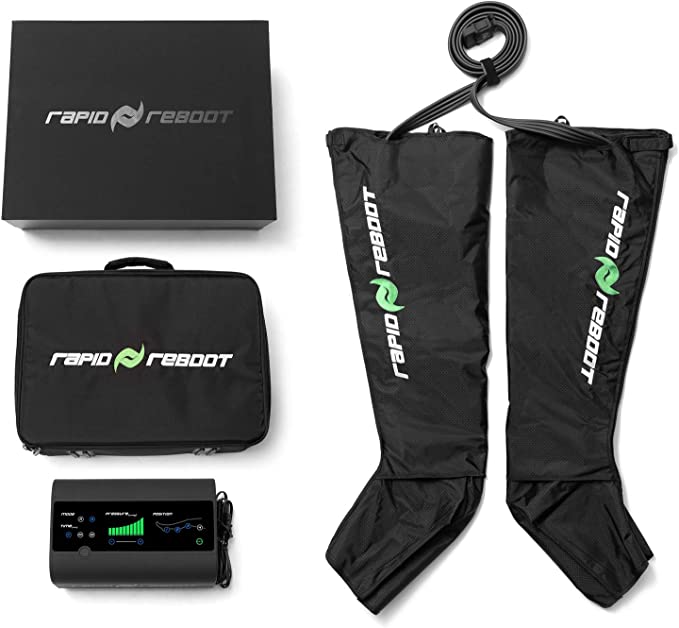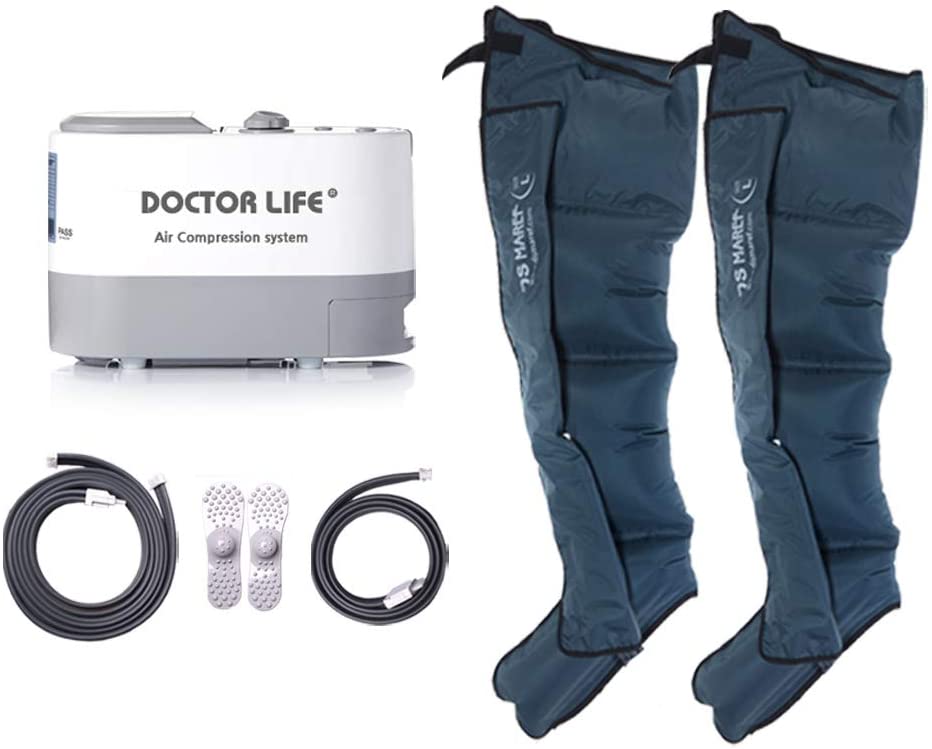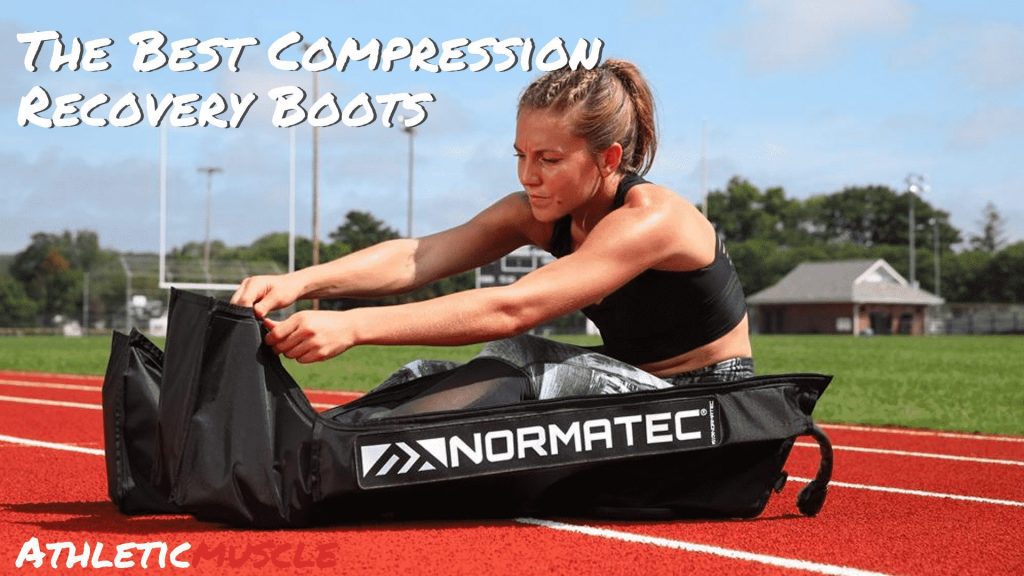Compression boots have become the latest craze. They look a little bit like giant snow pants or boots. And if you’ve seen them around social media, fitness blogs, or even at your local sports clinic, you may be wondering what the fuss is all about.
Surprisingly, in the sports rehab realm, compression recovery boots aren’t necessarily a new and upcoming tool. Physical therapists and other sports rehab professionals have actually been using similar devices on their patients for many years.
While many compression recovery boots claim that you’ll get slimmer legs and softer skin, this isn’t exactly what they’re all about. Below, we’ll dive into what exactly compression recovery boots are and how they work. We’ll also provide in-depth reviews on our top five recovery boots. Let’s take a look!
| Image | Product | |
|---|---|---|
Most popular
| NormaTec Pulse 2.0 Recovery System
| View on Rogue Fitness |
Best portable compression recovery boots
| Compex Ayre Compression Boot
| View on Rogue Fitness |
Best Overall
| Rapid Reboot Recovery System
| View on Amazon |
Best value
| Air Compression System By DSMAREF
| View on Amazon |
Most affordable
| Reathlete Leg Massager
| View on Amazon |
Overall #1 Pick
NormaTec Pulse 2.0 Recovery System
- Lightweight at 3.6 lbs and portable
- Full leg coverage
- Three modes and customized programming

The NormaTec compression recovery boot is one of the most popular recovery boots on the market. With customizable programs accessed by a touchscreen, these boots offer full leg coverage.
The three different modes include Recovery Flush, Rehab, and Custom Mode. This offers versatility for use. However, some reviews indicated that it wasn’t appropriate for their rehab criteria and that their healthcare professional did not recommend this particular brand. Yet, for general recovery after exercise, NormaTec seems to be highly effective.
The battery life is stated to last about two hours. Depending how long you use it for (many users report using it for 10-60 minutes at one time), the amount of use you get out of each battery charge may vary. Yet, the battery recharging process has been reported to take quite a bit of time.
This recovery boot also comes with a new Bluetooth app, which allows you to control it from your smartphone. This really sets this boot apart from other brands.
It’s also very lightweight and fully portable. However, the carrying case is sold separately.
Generally, this product is best for teams or high performance athletes. This is mostly due to the high cost. Yet, the product does come with a 2-year warranty.
Top 5 Best Compression Boots for Recovery
Check out our below list for a summary of our results. Keep on reading to learn more about your compression recovery boot options!
- NormaTec Pulse 2.0 Recovery System (Most Popular)
- Compex Ayre Compression Boot (Best Portable Compression Recovery Boots)
- Rapid Reboot Recovery System (Best Overall)
- Air Compression System By DSMAREF (Best Value)
- Reathlete Leg Massager (Most Affordable)
In this article, I’ll be taking a look at the various types of recovery boots on the market, what to look for before purchasing, and the benefits of using these items in your recovery regime.
Read Also: Best Percussion Massage Guns For Recovery
What Are Compression Recovery Boots?
Compression recovery boots are inflated leg sleeves. When inflated with air, they provide moderate compression to the legs, which can improve blood flow and lymphatic drainage.
What is lymphatic drainage? The lymphatic system helps rid the body of toxins and waste. It transports lymph, a fluid containing white blood cells, throughout the body, and is an invaluable piece in the immune and circulatory systems.
After intense exercise, the lymphatic system can become overwhelmed and may struggle to drain fluid properly from certain areas. You may have experienced this before when you notice your hands, fingers, or legs appear more puffy after a particularly tough workout.
Ultimately, the demands of an intense workout leave a build-up of toxins and other compounds, like lactic acid, in the tissue. In turn, this can make recovery longer and more difficult. It may also cause swelling, particularly in the lower legs. Yet, by helping the movement of stagnant fluid and allowing fresh fluid provide nourishment to the affected area, regeneration and recovery can take place.
In a way, compression boots work similar to manual lymphatic drainage, which is frequently used by massage therapists and sometimes by physical therapists.
This type of massage uses gentle pressure to encourage fluid movement. In fact, a 2015 study published in the Journal of Physical Therapy Science found that manual lymphatic drainage was very effective at accelerating lactic acid removal and improving the regenerative processes associated with muscle recovery. Further, the fact that similar devices have been used in rehabilitation settings for many years says something to their effectiveness, which we’ll discuss in greater detail in the next section.
Are They Effective?
Do recovery boots help improve your skin appearance and make your legs thinner? This is debatable. Generally, this shouldn’t be the goal of using recovery boots.
Instead, you’re best to use a compression boot to help accelerate recovery and potentially get you back in the gym or back to training faster.
As mentioned above, massage therapy provides manual lymphatic drainage similar to compression recovery boots. Recovery boots are also very similar to intermittent pneumatic compression (IPC) devices. Pneumatic compression is frequently used to help improve venous function in individuals who struggle with edema, have diabetes, have a high risk of deep vein thrombosis (blood clots that occur in the legs), or have a high risk of pulmonary embolism (which is a blockage of one of the arteries in the lungs that typically arises from a blood clot within the legs).
In fact, many rehabilitation clinics use the NormaTec compression system to address the above issues, as well as to help patients recover from injury and exercise. The goal when using this device is to improve venous function, reduce muscular soreness, decrease muscular fatigue, improve recovery, decrease lymphedema, and enhance overall healthy circulation. Additionally, the NormaTec recovery boot is one of the most talked about compression boots on the market, which is included in our product reviews below.
Overall, the compression boot has been compared to foam rolling, cold-hot contrast therapy, compression tights, and manual compression therapy. Foam rolling is a recovery option used by many athletes. It also uses moderate compression to alleviate muscle soreness and facilitate fluid movement by rolling over a foam cylinder.
Cold-hot contrast therapy, on the other hand, involves the constriction and dilation of blood vessels by alternating between cold and hot water. This can help pump excess fluid away from the treated area. Yet, contrast therapy faces the obstacle of setting up two different tubs with two different water temperatures, as well as spending the time alternating between the two.
Compression tights are garments worn by athletes and individuals with medical conditions to help facilitate blood flow back to the heart. They work similar to compression boots, helping to enhance circulation and improve muscular soreness, but the research is much more mixed when it comes down to whether these tights are effective or not.
Lastly, and as previously touched on, manual compression therapy involves hands-on treatment from a certified massage therapist or physical therapist which, again, promotes the movement of fluid. This is a very effective and highly skilled technique that should only be performed by massage or physical therapists that have undergone proper training.
Generally, the compression boot may prove better than foam rollers. These boots typically use Peristaltic Pulse Technology which applies compression in the form of inflated air pulses to the legs. In a way, this mimics the naturally pumping that occurs with muscle movement. This means it could provide a better alternative to foam rollers, but potentially not a better alternative to active recovery or manual compression therapy which provides a more targeted and expert treatment. In other words, the compression boots are a great self-recovery routine, especially if you want to sit back and relax while your legs recover. Yet, they shouldn’t replace any regular massage treatment entirely. Further, whether one is better than the other may come down to individual preference.
What Muscles/Injuries Can They Treat?
Compression recovery boots are great devices for those that struggle with vein issues in their legs. They may also be suitable for those that travel frequently and spend quite a bit of time sitting, such as on a plane or in a car. Pregnancy women can also benefit from using compression recovery boots since achy and swollen legs are common complaints during pregnancy.
A recovery boot is also great for soft tissue injuries, such as a strained muscle that has become inflamed, and for general recovery after exercise. In fact, using these compression recovery boots may help prevent future injuries from happening. They help your body fully recover so that when you go to train or exercise again, you likely won’t be overdoing it.
If you’re experiencing severe pain, compression recovery boots should not be used. If you are currently experiencing this pain, seek out immediate medical attention or a visit with your doctor. You should also not use recovery boots on fractures or on post-surgical areas. If you’re ever unsure about whether or not compression boots are right for you, check with your doctor, physical therapist, or massage therapist. They know you and your situation the best, and can make an informed decision to help further your recovery and healing.
Who Are Compression Boots Suitable For?
Compression boots are excellent choices for athletes who rely on their legs, such as runners or sprinters. Crossfitters may also find them useful, depending on the type of activity they performed. If you’ve been squatting or loading up the legs, you may find compression boots useful. However, if you’ve just completed an upper body workout, compression boots may not do a whole lot for your recovery.
Key Features to Consider When Buying a Compression Recovery Boots
So, you’re thinking about buying compression recovery boots. You’ve deemed them suitable for your activity or sport of choice. What should you know? What key features should you pay attention to?
Size – Leg Coverage
Compression recovery boots range in size from covering just the lower leg to the entire leg. While this is a personal preference, the size is something you want to be aware of. If you want the recovery boot to cover your entire leg, ensure you get one that does so. There are also options that come with full body coverage, which may be something some individuals may prefer as well.
Comfort
Reading reviews can go a long way with this one – especially since most recovery boots you won’t be able to try out before you buy. See what previous consumers said or what reviews comparing different boots have to say. Ideally, you want a boot that provides moderate pressure without discomfort.
Pressure – Intensity
Some brands come with different pressure intensity settings. Meanwhile, others don’t. The levels of pressure or number of programs may also vary. Sometimes, you can also completely customize the area on the legs targeted. In other words, pay attention to this when going to buy one! Determine what you need or want and then find a product that suits that.
Read Also: Choosing the Best Foam Roller
Massage Modes
High quality compression boots feel very similar to a real massage. They frequently also have an option to target set muscle groups, which can provide more isolated compression therapy. Further, some of the more higher priced versions come with options for dynamic flow, which is reactive to your heart rate, and other programs.
Portability
Are you planning on taking your recovery boots with you to the field or to an away game? You’ll want to ensure the product you buy is easily transportable. Many come with a rechargeable battery, and some also come with easy carrying and travel cases.
The Best Compression Recovery Boots Product Reviews
Compex Ayre Compression Boot
- 3 hours battery life
- Carrying case included
- Wireless control

The Compex Ayre Compression Boot comes at a much more affordable price than competitor brands. They are lightweight, with each boot having four separate compression chambers that can inflate together or separately.
These can also be used without a power outlet, making them great for individuals who are on-the-go. In addition, the carrying case makes them easy to bring with you on your travels, to the office, or anywhere else.
The major selling point for this boot is that it helps boost recovery after intense exercise. It also comes with all the parts, meaning you don’t need to go and purchase add-ons or accessories.
The interior and exterior linings are also made to prevent odor, which allows you to use it right after your workout. The battery lasts about 3 hours, and the hook-and-loop zipper makes them easy to put on and take off.
Rapid Reboot Recovery System
- Offers different sizing options
- Carrying case included
- 10 different pressure settings

As far as the best compression recovery boots go, the Rapid Reboot Recovery System goes above and beyond. It’s not just a boot. This product also includes whole body coverage attachment pieces, such as sleeves for your torso, arms, and shoulders. It comes with a two-year warranty, and a travel case. Basically, it’s everything you need in one-go.
It also comes with so many options for pressure and modes. It has 10 different pressure settings, three session duration options, and the option to deactivate certain chambers as you see fit or for when you want to isolate specific muscle groups (as you would request in a typical massage session). These features make it one of the most customizable compression boots you can find.
These boots are great for helping the body recover, especially in specifically targeted spots. The only downsides is the price, but considering you’re getting everything you need, it might be worth it – especially if you want to further your recovery and get back to training faster.
Air Compression System By DSMAREF
- More affordable than other options.
- Ability to use for only 15-30 minute sessions
- Portable and lightweight.

DSMAREF brings you a more affordable option when it comes to compression boots. The boots are light and very portable, yet at the same time, they provide an effective compression sensation to the legs.
This optimal compression allows the body to quickly flush waste, lymphatic fluid, and lactic acid from the legs. In fact, for 15-30 minutes of use, these compression boots are comparable to about 24 hours of rest.
These are a great option for the recreational athlete who doesn’t want to overspend on a pair of compression boots but wants to boost their recovery – even massage therapists report that these boots do what they say they will.

While the Reathlete Leg Massage is not the premium option, it is the most affordable option when it comes to the best compression recovery boots. They also come with a heated knee pad feature, which many other boots don’t, and adds to your recovery. Heat is wonderful at helping tight muscles relax, which can decrease muscular tension and soreness after your workout.
However, these compression boots come with a difficult set-up. Many consumers report having trouble getting them on. Yet, once they are on, they do an alright job of compressing the legs and boosting recovery.
It comes with a remote control for easy use. It further includes three pressure intensities and four modes. All in all, it’s quite effective at increasing blood flow and lymphatic drainage, while allowing you to relax. Lastly, it comes with a one-year warranty which brings a bit more peace of mind, especially when buying a less expensive brand.
Making Your Choice
Decide on what you want to get out of your compression boots, along with your budget. There are a variety of brands to choose from. If you’re wanting a reliable device for your entire team, the NormaTec compression boot may be right for you. If you have a tighter budget and don’t mind a bit of a hassle getting the boot on, the Reathlete boot may be best. Assess your needs, your budget, and begin improving your recovery time with a pair of the best compression recovery boots on the market.

